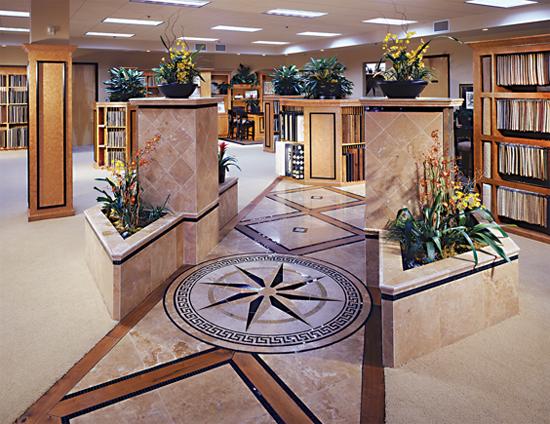Best Practices - December 2012
By Brian Hamilton
In the hyper-competitive builder trade where margins can be low, Residential Design Services of Anaheim, California separates itself from the competition by providing service well beyond the norm. “We build around our clients’ needs,” says co-owner and president James Gunckel. “We don’t walk in and say this is how we do business. We look at their needs and see how we can mold our business to meet their needs.”
One way the firm has done this is by providing a complete interior design service. The company, which does most of its business with large builders like Toll Brothers and KB Home, has showrooms and 11 design centers where home buyers can go not only to choose flooring but also to decide what countertops, window coverings, bathroom fixtures, lighting and even landscaping they’d like in their home.
“There are a lot of things that go into a home that we don’t do, like built-ins and garage flooring,” Gunckel says. “We have the ability to sit down and provide that service to the builder and take their customers through every option available. We provide a one-stop shop. We’ll work with the subs, the painters, and manage those options for the customer. We’ll collect the deposit for the builder, and manage all the contractual documentation.”
This service is aided greatly by a strong software system, but that’s only a tool. Gunckel says that some of his competitors offer a similar service, but it’s not easy to do well and mistakes can be very expensive. It takes a lot of expertise about home building, and timing is especially crucial. “For example, you have to know that if you are too far along, you can’t change the electrical,” Gunckel says. “Not a lot of companies are suited to do this.”
MANAGING GROWTH
In order to survive the downturn, Residential Design had to downsize every aspect of the organization, from employees to leases to subcontractors. Because the firm does no advertising, there was no promotions budget to cut. Fortunately Residential Design was well capitalized because, as Gunckel says, “You couldn’t get a loan if you didn’t have capitalization and ran a high risk of not surviving.”
Today, Residential Design has the opposite problem—it has to manage for growth. Business has picked up 30% this year because the builders have gotten busy in their market, and Gunckel says his business should grow another 30% next year. “Across the board, we could hire about 30 to 40 people today if we could find them,” Gunckel says. “We’ve probably hired that many in the last 90 days.” The biggest problem, he says, is that a lot of the skilled labor left the market for other professions during the downturn and, for the most part, they aren’t coming back. “We’re out looking for skilled people every day but we can’t find them. We have ads almost daily.” The company isn’t set up to provide the training for as many people as it needs. However, it does train its on-staff flooring installers. New hires spend a couple of years learning from a seasoned pro before they’re allowed to work on their own.
The skilled labor problem isn’t just a problem for his business, Gunckel says. The home builders are feeling the same pinch. “The industry has been hurt so badly and everyone is concerned about the ability to manage financial and production. A lot of the labor is gone, a lot got laid off and moved into other industries.”
Gunckel says he’s excited about the turnaround and knows he and his partner can manage the growth effectively, partly because they’ve done it before. One thing that is helping Residential Design cope with the new problem is its longstanding relationship with subcontractors. “We’ve always got a core of installer employees and subs,” Gunckel says. “This gives us flexibility when we get busy. We outsource when we have more business than we can handle.”
COMMITMENT TO CUSTOMERS
The success of Residential Design Services comes down to how it treats its clients, Gunckel says. The firm has dedicated account managers who call on companies and bid on projects. It’s about building relationships, whether directly through account managers or working through area home builder’s associations.
“We have a proven commitment to excellence,” Gunckel says. “We have found in this industry that for longevity you’ve got to build the assembly line efficiently but you also have to be flexible.”
|
MERGE FOR SURVIVAL |
|
Residential Design Services was formed by the merger of two companies, James Gunckel's JPS Surface Solutions and Rick Scholten's Residential Design Services, in 2009. As Gunckel notes, the merger was a way for the two competitors to survive. Both were hard hit by the recession. In 2006, as two separate companies, they did over $200 million in business. When they combined, they were struggling to stay above $30 million. The owners decided to take the Residential Design name because it was in Orange County, California and San Diego, which was a better financed market. |
|
CALIFORNIA BUILDING TRENDS |
|
Residential construction is picking up across the board for Residential Design Services. President James Gunckel says there's a definite trend toward smaller, 1,200 to 1,800 square foot spaces in urban areas, while there's also a resurgence of larger homes, mostly in the coastal areas. Even smaller entrepreneurial builders are back after several years' absence from the market, and there the margins are better. One aspect of the builder market that's different for now is that there are far fewer upgrades to the standard flooring packages offered by the major builders. And that, Gunckel says, is because the upgrades usually can't be incorporated into a homeowner's mortgage, so they have to pay cash. Of course, for some customers, the cash isn't a problem, but for most, it is. |
Copyright 2012 Floor Focus
Related Topics:The International Surface Event (TISE), Coverings
